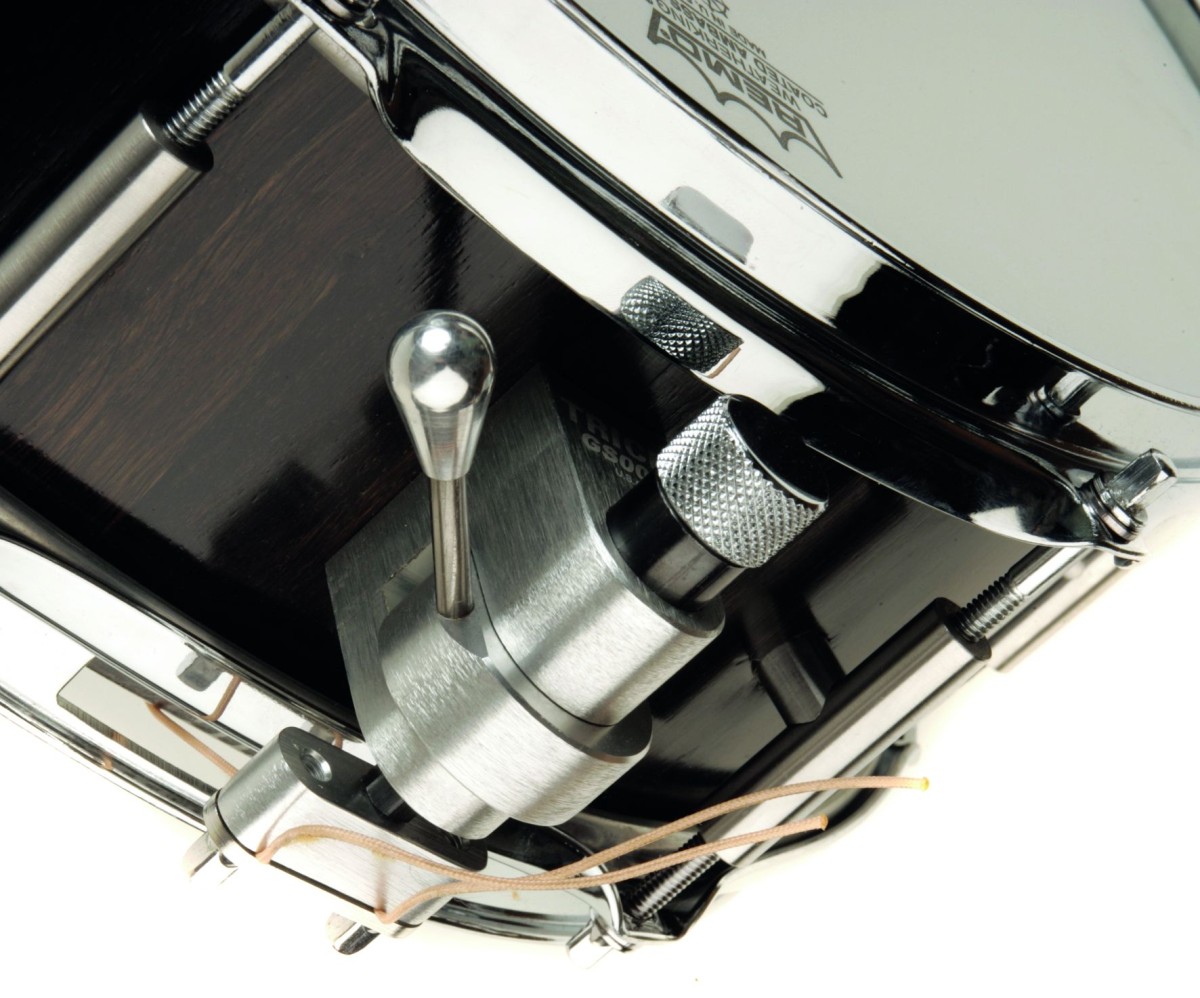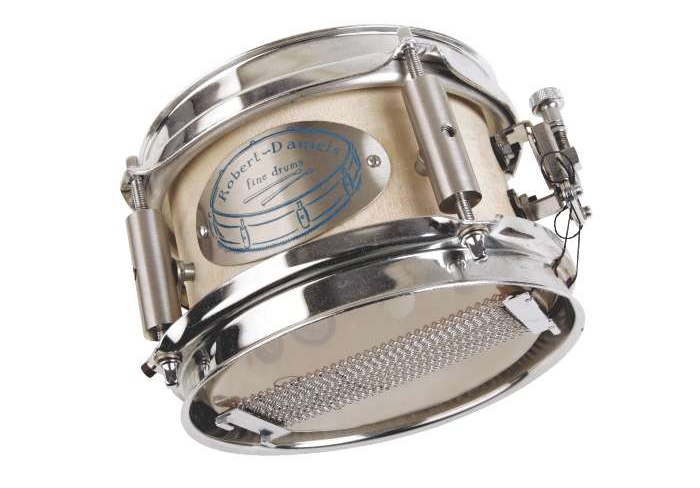MusicRadar Verdict
The bog oak snare is the only standard size snare here and it is fabulous… at a fabulous price that extremely few can contemplate. It's worth noting, however, that classical musicians regularly take out second mortgages for their fiddles. Robert only makes a few drums per year so his skills are most certainly aimed at the discerning - and loaded - lover of fine things.
Pros
- +
Unique hand built drums of great rarity and beauty with great tone.
Cons
- -
Such exclusivity comes at an eye-watering cost.
MusicRadar's got your back





More and more British craftsmen are making custom drums, and Robert Daniels' Fine Drums are probably the most exclusive. Robert only makes two or three snares a year, but the list of stars who have bought one is impressive.
Evelyn Glennie has an early model in recycled mahogany and Gilson Lavis has an ebony piccolo. Other customers include Gary Wallis, Karl Van Den Bossche and Rowland Rivron.
Heads on the block
Robert uses the stave block construction method, so his drums have solid, rather than ply, shells. They are at least 1/2" thick for strength. Each block is cut, butted together and 'rub' joined.
"You put PVA glue on one side," Robert explains, "butt it up against the other and rub it together so the glue is squeezed out and pulls the timber together. The joint becomes stronger than the wood itself. When the shell comes out of the mould it is multi-faceted. It is then turned on a lathe while power sanded. "That's a minimum of machinery usage and a maximum of hand tools."
Robert has only ever made around 25 drums and each is a one-off. The three examples reviewed here are wildly different. The bog oak that the 14"x5" drum is made from is, according to Robert, at least 4,500 years old. It was obtained from the Cambridgeshire fens where farmers sometimes discover bog oaks up to 100" long while out ploughing.
"It may actually be pine or birch but it's still called bog oak," says Robert. "Bog oak that is actually oak is rare. This one is bog oak oak, so to speak. I got a load of logs but all I could get out of them was this one drum!" The drum is smooth inside and out, the shell is 3/4" thick. All metal parts are bought in so the strainer is the superb, aluminium/stainless steel Trick.
Want all the hottest music and gear news, reviews, deals, features and more, direct to your inbox? Sign up here.
The eight double-ended pipe lugs are made specially for Robert. They are 1/2" diameter solid stainless steel, fixed centrally using high tensile steel cap bolts. Unlike most modern drums, which have sharp 45º bearing edges, Robert's drums have a beautifully graduated inner curve that falls smoothly into the drum. He suggests it has a 'loudhailer' effect on sound projection. The air hole - or sound hole - is also smoothly rounded and 1" in diameter. The idea is again to project the sound, particularly the bottom end.
The drum shell is dark brown, almost black. It is not stained, however, but treated with a finishing oil, a varnish with Tung oil, "a natural, hard, waterproof finish. The bog oak will absorb and release moisture, so it needs something that will hermetically seal it."
Sound-wise the drum is a dream. With the batter fairly loose it has a gorgeous resonating, clangy, wet sound. Tune it up a bit and the sound becomes taut and clean with much less spread, but still responsive.
This is one super flexible drum. You can roll on the (rounded) bearing edge, the centre, sweet spot backbeat is fat and deep, and rim shots have a buoyant, Gene Krupa-style ping.
Everything about this drum speaks class.
Unusual instruments
Andy Gangadeen's tiny snare is 4" deep but only 51/2" in diameter. It is fitted with a 6" Remo Diplomat batter - Robert's shells are always 1/2" undersized for better resonance. The shell is English ash, white limed and finished with clear French polish.
There's a simple, vintage Ludwig piccolo-style throw-off and a specially made 6", 20-strand snare. The sound is dry, but still resonant, certainly enough to play rolls all over. Rim shots are knife sharp, sounding a bit like a tiny Brazilian tambourim. The drum's also good for snappy, rapid drum'n'bass-style beats, hence, we imagine, Andy's interest.
The three-in-one set was the idea of David Gray's drummer, Clune. Robert says, "Clune wanted a dry-ish sound so we decided on ply construction, which is also very strong. I didn't make these shells - I'm the stave man. They were handmade though, with each 8" shell layered up ply by ply. As they are ply shells the bearing edges are cut normally, not curved. The shells are still pretty thick, about 3/8" (almost 1cm) and the top wooden hoops are an inch square."
The three shells are mounted on a brushed steel plate. Each resonant bottom head is slotted into an 8" hole, the shell sits on top and the tension bolts go through the plate so that the plate takes the place of the bottom hoops. Each drum has six black powder coated brass lugs.
There are no throw-offs, but each drum has a butt plate on both sides and snare tension can be altered by a threaded knob.
Although the drums are all 8" in diameter they have different depths giving different pitches and responses. The 3" is the driest, the 7" lively, but the 51/2" is the liveliest. Sustain is limited but there's plenty of tone. The wood rims add warmth and there's an almost tabla-like ping when you play rim shots.
Holy moulah!
Wondering about the cost? You may want to sit down. The starting point is £1,000 for a 14"x6" snare drum in a European hardwood such as ash, birch or oak. (Gangadeen's tiny drum would be £500.) The same in a tropical hardwood is £1,500.
The reason? "I want to put people off buying tropical hardwoods. They are also harder to work," says Robert. The price rises to £2,000 for exotic timbers. "Ebony is the best wood, almost a cross between wood and metal, it's so hard." Bog oak is "beyond rare and exotic." Accordingly, its suggested price is a whopping £2,500.
Clune's triple drum and Gangadeen's tiny snare show the flexibility of Fine Drums. Every drum is a different experimental prototype.
MusicRadar is the number 1 website for music makers of all kinds, be they guitarists, drummers, keyboard players, djs or producers...
GEAR: We help musicians find the best gear with top-ranking gear round-ups and high- quality, authoritative reviews by a wide team of highly experienced experts.
TIPS: We also provide tuition, from bite-sized tips to advanced work-outs and guidance from recognised musicians and stars.
STARS: We talk to musicians and stars about their creative processes, and the nuts and bolts of their gear and technique. We give fans an insight into the actual craft of music making that no other music website can.
